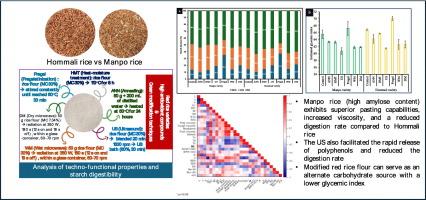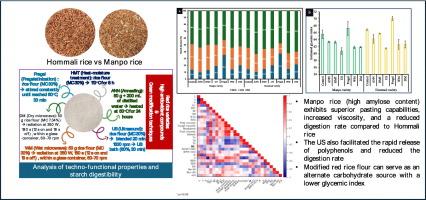不同直链淀粉含量的富含多酚的红米粉的新工艺功能特性和淀粉消化率调控的可持续技术
IF 9.8
1区 农林科学
Q1 CHEMISTRY, APPLIED
引用次数: 0
摘要
使用可持续技术对红米粉进行改性,包括ANN(退火)、HMT(热湿处理)、US(超声波)、Pregel(预糊化)、WM(湿微波处理)和DM(干微波处理)。在相同的处理条件下,直链淀粉含量高的满坡米粉比中高直链淀粉大米(Hommali米)的面粉表现出更高的峰值粘度。在两个品种中,经过人工神经网络和HMT处理后,膨胀力的降低与这些面粉的糊化行为相对应。所有样品均表现出明显的剪切减薄特性。预凝胶样品消化速度快,满坡米的RDS最高为35.4% %,Hommali米的RDS最高为37.3% %。而美国样品的结构发生了变化,导致多酚的生物可及性增强,消化率降低。满坡稻和Hommali稻的eGI最低,分别为60.7和61.5,180 min时多酚生物可及性分别为37 %和28.8 %。本研究记录了可持续做法对红米粉特性的影响,从而增强其未来商业化的烹饪应用。本文章由计算机程序翻译,如有差异,请以英文原文为准。


Sustainable techniques to enhance novel techno-functional properties and modulate starch digestibility of polyphenol-rich red rice flours with varying amylose content
Red rice flours performed modification using sustainable techniques, including ANN (annealing), HMT (heat moisture treatment), US (ultrasound), Pregel (Pregelatinization), WM (wet-microwave treatment), and DM (dry-microwave treatment). Manpo rice flour, which is high in amylose, demonstrated higher peak viscosity compared to flours from medium-high amylose rice (Hommali rice), under the same treatment conditions. The reduction in swelling power observed after ANN and HMT treatment in both varieties corresponds with the pasting behaviors of these flours. All samples exhibited notable shear-thinning properties. Pregel samples exhibited rapid digestion, with the maximum RDS levels reaching 35.4 % for Manpo rice and 37.3 % for Hommali rice. While, the structure of US samples changed, resulting in enhanced polyphenol bioaccessibility and decreased digestion rate. The lowest eGI recorded in US samples was 60.7 for Manpo rice and 61.5 for Hommali rice, with polyphenol bioaccessibility at 180 min measured at 37 % and 28.8 %, respectively. This study documents the impact of sustainable practices on the properties of red rice flours, thereby enhancing its culinary applications for future commercialization.
求助全文
通过发布文献求助,成功后即可免费获取论文全文。
去求助
来源期刊

Food Chemistry
工程技术-食品科技
CiteScore
16.30
自引率
10.20%
发文量
3130
审稿时长
122 days
期刊介绍:
Food Chemistry publishes original research papers dealing with the advancement of the chemistry and biochemistry of foods or the analytical methods/ approach used. All papers should focus on the novelty of the research carried out.
 求助内容:
求助内容: 应助结果提醒方式:
应助结果提醒方式:


